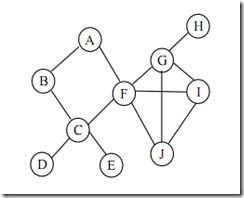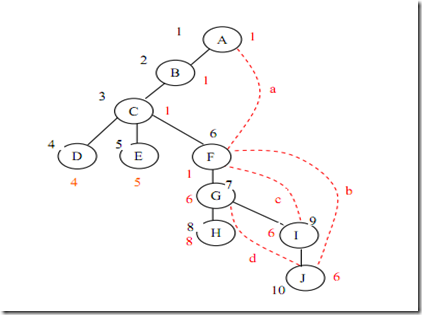[点连通度与边连通度]
在一个无向连通图中,如果有一个顶点集合,删除这个顶点集合,以及这个集合中所有顶点相关联的边以后,原图变成多个连通块,就称这个点集为割点集合。一个图的点连通度的定义为,最小割点集合中的顶点数。
A cut, vertex cut, or separating set of a connected graph G is a set of vertices whose removal renders G disconnected. Theconnectivity or vertex connectivity κ(G) is the size of a smallest vertex cut. A graph is called k-connected or k-vertex-connected if its vertex connectivity is k or greater. A complete graph with n vertices has no cuts at all, but by convention its connectivity is n-1. A vertex cut for two vertices u and v is a set of vertices whose removal from the graph disconnects u and v. The local connectivity κ(u,v) is the size of a smallest vertex cut separating u and v. Local connectivity is symmetric for undirected graphs; that is, κ(u,v)=κ(v,u). Moreover, except for complete graphs, κ(G) equals the minimum of κ(u,v) over all nonadjacent pairs of vertices u,v.
2-connectivity is also called "biconnectivity" and 3-connectivity is also called "triconnectivity".
Analogous concepts can be defined for edges. In the simple case in which cutting a single, specific edge would disconnect the graph, that edge is called a bridge. More generally, the edge cut of G is a group of edges whose total removal renders the graph disconnected. The edge-connectivity λ(G) is the size of a smallest edge cut, and the local edge-connectivity λ(u,v) of two vertices u,v is the size of a smallest edge cut disconnecting u from v. Again, local edge-connectivity is symmetric. A graph is called k-edge-connected if its edge connectivity is k or greater.
类似的,如果有一个边集合,删除这个边集合以后,原图变成多个连通块,就称这个点集为割边集合。一个图的边连通度的定义为,最小割边集合中的边数。
[双连通图 割点 与桥]
Point Biconnected Component 无向图点2连通分量与 cut point 割点
Edge Biconnected Component 无向图边2连通分量与 bridge 桥
如果一个无向连通图的点连通度大于1,则称该图是点双连通的(point biconnected),简称双连通或重连通。一个图有割点,当且仅当这个图的点连通度为1,则割点集合的唯一元素被称为割点(cut point),又叫关节点(articulation point)。
如果一个无向连通图的边连通度大于1,则称该图是边双连通的(edge biconnected),简称双连通或重连通。一个图有桥,当且仅当这个图的边连通度为1,则割边集合的唯一元素被称为桥(bridge),又叫关节边(articulation edge)。
可以看出,点双连通与边双连通都可以简称为双连通,它们之间是有着某种联系的
[双连通分支]
在图G的所有子图G’中,如果G’是双连通的,则称G’为双连通子图。如果一个双连通子图G’它不是任何一个双连通子图的真子集,则G’为极大双连通子图。双连通分支(biconnected component),或重连通分支,就是图的极大双连通子图。特殊的,点双连通分支又叫做块。
[求割点与桥]
该算法是R.Tarjan发明的。对图深度优先搜索,定义DFS(u)为u在搜索树(以下简称为树)中被遍历到的次序号。定义Low(u)为u或u的子树中能通过非父子边追溯到的最早的节点,即DFS序号最小的节点。根据定义,则有:
Low(u)=Min
{
DFS(u)
DFS(v) (u,v)为后向边(返祖边) 等价于 DFS(v)<DFS(u)且v不为u的父亲节点
Low(v) (u,v)为树枝边(父子边)
}
一个顶点u是割点,当且仅当满足(1)或(2)
(1) u为树根,且u有多于一个子树。
(2) u不为树根,且满足存在(u,v)为树枝边(或称父子边,即u为v在搜索树中的父亲),使得DFS(u)<=Low(v)。
一条无向边(u,v)是桥,当且仅当(u,v)为树枝边,且满足DFS(u)<Low(v)。
[求双连通分支]
下面要分开讨论点双连通分支与边双连通分支的求法。
对于点双连通分支,实际上在求割点的过程中就能顺便把每个点双连通分支求出。建立一个栈,存储当前双连通分支,在搜索图时,每找到一条树枝边或后向边(非横叉边),就把这条边加入栈中。如果遇到某时满足DFS(u)<=Low(v),说明u是一个割点,同时把边从栈顶一个个取出,直到遇到了边(u,v),取出的这些边与其关联的点,组成一个点双连通分支。割点可以属于多个点双连通分支,其余点和每条边只属于且属于一个点双连通分支。
对于边双连通分支,求法更为简单。只需在求出所有的桥以后,把桥边删除,原图变成了多个连通块,则每个连通块就是一个边双连通分支。桥不属于任何一个边双连通分支,其余的边和每个顶点都属于且只属于一个边双连通分支。
[构造双连通图]
有桥的连通图必然有割点,有割点的连通图不一定有桥(下图可以很明显得到)

如果一个图有桥,则把此图变成无桥的图的最优策略:
一个有桥的连通图(其必然有割点),如何把它通过加边变成边双连通图?方法为首先求出所有的桥,然后删除这些桥边,剩下的每个连通块都是一个边双连通子图。把每个双连通子图收缩为一个顶点,再把桥边加回来,最后的这个图一定是一棵树,边连通度为1。
统计出树中度为1的节点的个数,即为叶节点的个数,记为leaf。则至少在树上添加(leaf+1)/2条边,就能使树达到边二连通,所以至少添加的边数就是(leaf+1)/2。具体方法为,首先把两个最近公共祖先最远的两个叶节点之间连接一条边,这样可以把这两个点到祖先的路径上所有点收缩到一起,因为一个形成的环一定是双连通的。然后再找两个最近公共祖先最远的两个叶节点,这样一对一对找完,恰好是(leaf+1)/2次,把所有点收缩到了一起。

如果一个图无桥有割点,则把此图变成双连通的最优策略:

如果一个图既有桥,又有割点,则把此图变成双连通的策略:(不是最优。。。)
1 首先把图变成无桥的
2 把有割点无桥的图变成双连通
(显然这个算法不是最优的。。关键问题是把图变成无桥的图的时候的策略选择!这个需要高手指点。。。)
A biconnected component (or 2-connected component) in graph theory is a maximalbiconnected subgraph. Any connected graph decomposes into a tree of biconnected components called the block tree of the graph. The blocks are attached to each other at shared vertices called cut vertices or articulation points. Specifically, a cut vertex is any vertex that when removed increases the number of connected components.
算法的基本描述:
The classic sequential algorithm for computing biconnected components in a connected undirected graph due to John Hopcroft andRobert Tarjan (1973) [1] runs in linear time, and is based on depth-first search. This algorithm is also outlined as Problem 22-2 of Introduction to Algorithms (both 2nd and 3rd edition).
The idea is to run a depth-first search while maintaining the following information:
- the depth of each vertex in the depth-first-search tree (once it gets visited), and
- for each vertex v, the lowest depth of neighbors of all descendants of v in the depth-first-search tree, called thelowpoint.
The depth is standard to maintain during a depth-first search. The lowpoint of v can be computed after visiting all descendants of v (i.e., just before v gets popped off the depth-first-search stack) as the minimum of the depth of all neighbors of v (other than v's parent in the depth-first-search tree) and the lowpoint of all children of v in the depth-first-search tree.
The key fact is that a nonroot vertex v is a cut vertex (or articulation point) separating two biconnected components if and only if v's lowpoint is at least as large as v's depth. This property can be tested once the lowpoint of v is computed (i.e., just before v gets popped off the depth-first-search stack), and if true, v separates the graph into different biconnected components. This can be represented by computing one biconnected component out of the descendants of v (by traversing the depth-first-search tree), and henceforth pretending that v had no children in the depth-first-search tree, so that the subgraph abovev will not descend into v's ancestors.
The root vertex must be handled separately: it is a cut vertex if and only if it has at least two children. Thus, it suffices to simply build one component out of each child subtree of the root (including the root).

Each color corresponds to a biconnected component. Multi-colored vertices are cut vertices, and thus belong to multiple biconnected components.
引入割点的目的: 如果我们去掉图中的某个点之后,那么这个图是否还是连通的!
引入2连通分量(块)的目的:图的某个子图是否可以去掉一个点之后,仍然是连通的。也就是说相对于这个子图,没有割点。此图的割含有两个点。
(注意一个图的割和割点不是一个概念!)
Reference :
http://www.byvoid.com/blog/biconnect/ byvoid的NX文章
Wiki 配图
中科院研究生院算法分析设计讲义(陈老师)